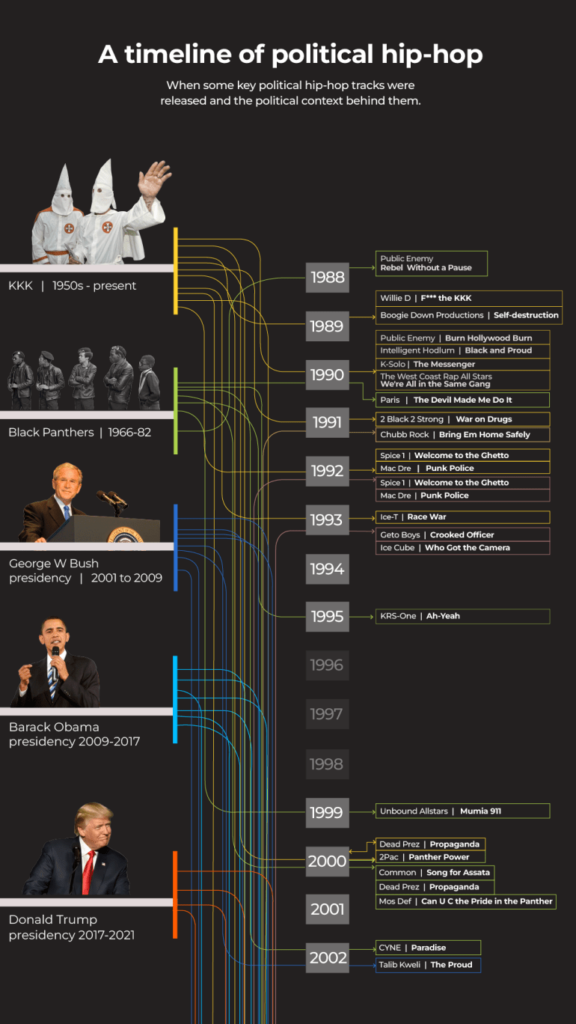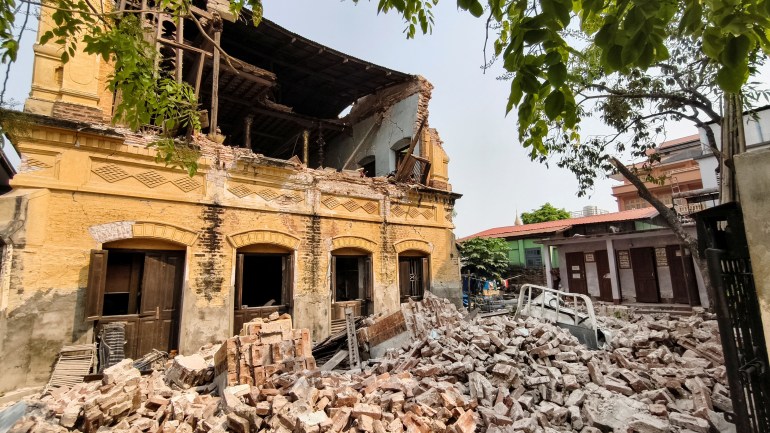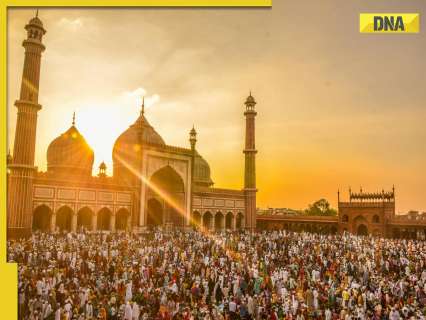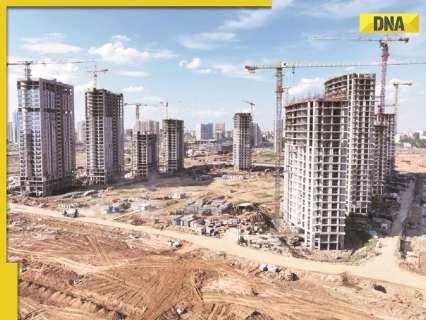From beats to ballots: What political rap lyrics tell us

What role has hip-hop played in activism? From the 1980s, hip-hop has essentially enabled marginalised voices to break through to the mainstream. The song Girl (Cocaine) That’s Your Life, released by Too Short in 1985, explores the gritty reality of a woman entrenched in street culture, examining her daily struggles, difficult decisions, and the inevitable repercussions of her chosen lifestyle. Since age thirteen what have I seenA lotto of base heads straight coke fiendsSnorting, puffing, that’s the lifeBut it’s all over when you hit that pipe “We [the Black community in America] were getting these first-person narratives from voices that were not in the mainstream. The voices of the unheard were speaking through rap. Instead of rioting they now had a platform to express themselves,” explained Arnold. In 1987, New York hip-hop rap group Public Enemy, known for raising political issues, media manipulation, and systemic racism in their lyrics, released their debut album, Yo! Bum Rush the Show. The group’s subsequent album, It Takes a Nation of Millions to Hold Us Back (1988) established its legacy in both musical achievement and social advocacy. In Compton, California, N.W.A (Niggaz With an Attitude) release of F**k the Police, which featured on its 1988 album Straight Outta Compton, addressed systemic issues of police brutality and racial profiling. F–k the police comin’ straight from the undergroundA Young nigga got it bad ’cause I’m brownAnd not the other colour so police thinkThey have the authority to kill a minority The lyrics prompted widespread outrage among conservatives, culminating in the FBI sending a formal letter of condemnation to N.W.A’s record label regarding the song’s perceived anti-law enforcement message. Even non-political rappers began to incorporate political messages into their songs, said Arnold, demonstrating how deeply political discourse had permeated hip-hop culture. This influence was so pervasive that artists with no explicit ideological stance found themselves engaging with political themes. “There are only a few artists and groups who are political ideologues. Everything else is occasional political commentary,” said Arnold. “In terms of political ideology, you have Public Enemy, Paris, the Coup, maybe Boogie Down Productions, in the late 80s, early 90s. In the early 2000s, you have Dead Prez and Immortal Technique. On top of that, you have Ice Cube developing a political consciousness that’s evident on his first and second solo albums but then fades into the background on subsequent albums.” Which major incidents have inspired political hip-hop lyrics? One was the 1991 acquittal of four White Los Angeles police officers who had been videotaped severely beating Rodney King, a Black man. The verdict led to six-day-long riots in Los Angeles, resulting in more than 60 deaths, 12,000 arrests and almost $1bn in property damage. The incident inspired Ice Cube to write the song We Had to Tear This Mothaf**a Up, which was released on his 1992 album, The Predator: Not guilty, the filthy, devils tried to kill meWhen the news get to the hood the ni**as will beHotter than cayenne pepper, cuss, bustKickin up dust is a must His former N.W.A. rap mate, Dr Dre, also released a response to the LA riots in his 1992 album The Chronic, The Day the Nig**az Took Over: Mi not out for peace and mi not Rodney KingDe gun goes click, mi gun goes bangDem riot in Compton and dem riot in Long BeachDem riot in L.A. ’cause dem no really wanna seeNiggas start to loot and police start to shoot The first line explicitly rejects calls for peace and expresses the frustrations of the Black community. King himself took a more conciliatory tone during a news conference on May 1, 1992, during the riots. Hoping to quell the violence, he famously stated: “Can’t we all just get along?” “Police brutality is a theme. It’s not just one thing, it’s not just: Oh, Rodney King got beat up. All of these people got beat up. They’re still getting beat up. And it didn’t end in 1992,” said Arnold. Another incident which inspired lyrics was the fatal shooting of Trayvon Martin by George Zimmerman, a neighbourhood watch volunteer in Sanford, Florida, in February 2012. The following year, Zimmerman was acquitted. The shooting ignited national outrage, raising intense discussions about racial profiling, gun control legislation, and Florida’s controversial “Stand Your Ground” law. Hip-hop rapper Plies, who co-founded the independent label Big Gates Records, released We Are Trayvon in 2012, promoting the Trayvon Martin Foundation started by Trayvon’s parents with the goal of raising awareness about gun violence. I never thought that wearing no hoodie, could cost you your lifeAnd I never thought you could just kill somebody and go out the same night. (same night)Every dog that you see that bark, don’t mean that he biteAnd everything that’s Black ain’t even, everything that’s pure ain’t white [embedded content] In 2014, 17-year-old Laquan McDonald was fatally shot by Chicago Police Officer Jason Van Dyke. Police dash-cam footage later emerged, revealing that McDonald had been walking away from Van Dyke when the officer fired 16 shots at the teenager. The withholding of this video evidence triggered huge demonstrations and public outcry. Two years after the incident, rapper Vic Mensa released 16 Shots: He never had a chance, and we all know it’s cause he BlackShot ’em sixteen times, how f*cked up is that?Now, the police superintendent wanna double backCops speeding up to the block like a running back Officer Van Dyke was found guilty of second-degree murder and 16 counts of aggravated battery in 2018 but was released in 2022 after serving three years of his sentence. In 2015, Sandra Bland, a 28-year-old African American woman, was pulled over by law enforcement in Prairie View, Texas. What began as a routine traffic stop for failing to signal a lane change quickly spiralled into a confrontation that resulted in her arrest on charges of allegedly assaulting a police officer. Three days later, officials discovered her lifeless body in her cell at Waller County Jail. Although authorities determined she died by suicide through hanging,
Foreign aid rushed to quake-hit Myanmar as more than 1,600 killed

Foreign rescue teams and supplies have arrived in Myanmar to help the impoverished country cope with a magnitude 7.7 earthquake that killed more than 1,600 people and left thousands wounded. The deadly quake, followed by a second magnitude 6.4 tremor, hit midday on Friday with an epicentre near Mandalay, the country’s second-largest city, bringing down dozens of buildings and damaging infrastructure, such as the airport. Myanmar’s neighbours – including India, China, Malaysia, and Singapore – dispatched aircraft and warships carrying relief supplies and rescue teams. Thailand, where at least 17 people died due to the earthquake, also sent aid to Myanmar. A view shows debris next to a damaged building in Mandalay, Myanmar [Reuters] On Sunday, a convoy of 17 Chinese cargo trucks carrying critical shelter and medical supplies was expected to reach Mandalay, after making the arduous journey by road from Yangon. Beijing said it sent more than 135 rescue personnel and experts along with supplies such as medical kits and generators, and pledged about $13.8m in emergency aid. Two Indian C-17 military transport aircraft were able to land late on Saturday at Naypyidaw with a field hospital unit and some 120 personnel, who were then to travel north to Mandalay to establish a 60-bed emergency treatment centre, India’s Ministry of External Affairs said. Advertisement Russia’s Ministry of Emergency Situations said it had flown 120 rescuers and supplies to Yangon, and its Ministry of Health said Moscow has also sent a medical team. (Al Jazeera) The World Health Organization said it was mobilising its logistics hub in Dubai to prepare trauma injury supplies. The global health body said it was coordinating its earthquake response from its Geneva headquarters “because we see this as a huge event” with “clearly a very, very big threat to life and health”. The United States, the European Union and the United Kingdom also sent emergency aid. Meanwhile, an initial report on earthquake relief efforts issued on Saturday by the United Nations Office for the Coordination of Humanitarian Affairs (OCHA) warned that “severe shortage of medical supplies is hampering response efforts.” ‘No aid in sight’ “All military and civilian hospitals, as well as healthcare workers, must work together in a coordinated and efficient manner to ensure effective medical response,” Myanmar’s military leader Min Aung Hlaing said, according to state-run media. But in some of Myanmar’s hardest-hit areas, residents told the Reuters news agency that government assistance was scarce so far, leaving people to fend for themselves. The entire town of Sagaing near the quake’s epicentre was devastated, resident Han Zin said. “What we are seeing here is widespread destruction – many buildings have collapsed into the ground,” he said by phone, adding that much of the town had been without electricity since the disaster and that drinking water was running out. Advertisement “We have received no aid, and there are no rescue workers in sight.” In Mandalay, a rescue worker told Reuters most operations were being conducted by small, self-organised resident groups that lack the required equipment. Meanwhile, a magnitude 5.1 earthquake hit near Mandalay, the US Geological Survey said, with no casualties reported so far. Al Jazeera’s Tony Cheng, reporting from the city, said many people slept outside on Saturday night, fearing even brief aftershocks could collapse already severely damaged buildings. “People are choosing to sleep either on the streets next to their houses or in tent cities, gathered together for comfort.” Adblock test (Why?)
‘Eid of Sadness’: Gaza marks festival amid Israeli bombings, lack of food

Palestinians in the Gaza Strip had little to celebrate as they marked Eid al-Fitr with rapidly dwindling food supplies and no end in sight to the Israeli bombardment. Many held prayers outside demolished mosques on the day marking the end of the fasting month of Ramadan, as at least 20 Palestinians were killed on Sunday, most of them women and children. The Muslim festival is supposed to be a joyous occasion, when families gather for feasts and buy new clothes for children – but most of Gaza’s two million Palestinians are just trying to survive. “It’s the Eid of Sadness,” Adel al-Shaer said after attending outdoor prayers in the central town of Deir el-Balah. “We lost our loved ones, our children, our lives, and our futures. We lost our students, our schools, and our institutions. We lost everything.” Twenty members of his extended family have been killed in Israeli attacks, including four young nephews just a few days ago, he said as he broke into tears. On March 18, Israel abruptly ended a fragile two-month ceasefire as it resumed its intense bombing campaign and ground operations in Gaza. Israel has since killed hundreds of Palestinian civilians and has allowed no food, fuel or humanitarian aid to enter for four weeks. Advertisement Arab mediators are trying to get the truce back on track, and Hamas said on Saturday it had accepted a new proposal from Egypt and Qatar, the exact details of which were not immediately known. Israel said it had advanced its own proposal in coordination with the United States, which has also been mediating. Israel’s genocide in Gaza has killed more than 50,000 Palestinians, according to the enclave’s Health Ministry. Adblock test (Why?)
Crescent moon sighted in Delhi, Lucknow, Bengaluru, Chennai and.., Eid-ul-Fitr to be observed tomorrow

The country will observe Eid-ul-Fitr tomorrow, i.e., March 31, as the crescent moon has been sighted in several cities, Islamic religious leaders announced.
ATS Homekraft’s Yamuna Expressway Project receives overwhelming response, sells 400 plots for Rs..

ATS Homekraft sells 400 plots at its ‘Province D Olympia’ project on Yamuna Expressway, with plans for future phases.
Six dead, five injured after tree gets uprooted near Gurdwara Manikaran Sahib in Himachal Pradesh

At least six people died and five were injured after a hollow tree was uprooted near the Gurdwara Manikaran Sahib parking area in Kullu on Sunday and fell on them.
Trump admin’s ‘sloppy’ Signal leak put Democrats back on offense, Sen Warner says

The Trump administration’s Signal group chat leak was a “sloppy” move that put Democrats on offense for the first time since President Donald Trump’s inauguration, Sen. Mark Warner, D-Va., said Sunday. Warner made the statement during an appearance on “Fox News Sunday,” telling host Shannon Bream that it is an insult to the American people for Trump officials to claim the information discussed in the group chat wasn’t classified. “This was so inappropriate. This was so sloppy. You know, Signal [is] fine, but don’t put classified information. If this had been any military officer or intelligence officer and they’d done that, they’d be fired,” Warner said. Warner fell short of stating that the information in the group chat made it “criminal,” as his colleague Sen. Richard Blumenthal has claimed. ELON MUSK TAPPED TO HELP LEAD INVESTIGATION INTO SIGNAL CHAT LEAK: WHITE HOUSE The encrypted messaging app Signal is now under the spotlight after it was revealed that top national security leaders had been in a group chat discussing plans to strike terrorists in Yemen. The chat also mistakenly included the Atlantic’s editor-in-chief, Jeffrey Goldberg. The chat was made public by a first-hand account of the group chat published by Goldberg in an article last week. The Trump administration has maintained that no classified information was shared in the chat, doubling down on Wednesday that the Atlantic’s story was a “hoax” after Goldberg published specific texts from the chat. JUDGE FIGHTING TRUMP OVER EL SALVADOR DEPORTATIONS ASSIGNED TO LAWSUIT OVER SIGNAL CHAT LEAK The messages included Secretary of Defense Pete Hegseth outlining that combat aircraft were set to take off and strike drones were ready for the operation, which were accompanied by timestamps. The use of Signal, though not in the context of war or military operations, has become increasingly more prevalent within the D.C. Beltway in recent months. The app grew in popularity after it was discovered in October 2024 that Chinese-linked hackers were targeting cellphone data in the U.S., including data belonging to Trump and and Vice President JD Vance during the campaign, Politico reported last week. Years before the Signal leak involving the Trump administration and subsequent outrage from Democrats and other critics, Democrats had repeatedly touted Signal as an additional precautionary measure against potential hacks. Democrats have emphasized in the fallout from last week’s leak that they do not object to the Trump administration’s use of Signal, only the sharing of classified information via the app. Fox News’ Emma Colton contributed to this report
Musk’s X and a Canadian man take action against Australian authorities for censoring his post

The Australian government has been taken to court by an internet personality known as “Billboard Chris,” who challenged the nation’s “eSafety” commission’s authority to geo-block a tweet criticizing the appointment of an Australian transgender activist to a World Health Organization board. Chris Elston, a Canadian national who often expresses his free speech through slogans and tweets on sandwich boards in public places, had a tweet of his geo-blocked by the Aussies – which was a ‘share’ of a U.K. Daily Mail article about the transgender activist headlined “Kinky secrets of UN trans expert revealed.” The activist, Teddy Cook, filed a complaint with Australia’s eSafety commissioner, which led to a request for X to censor it. X initially refused, but assented after the government issued a formal order to do so, according to Alliance Defending Freedom International, which is backing Elston. Elston is challenging the move before the Administrative Review Tribunal on Monday. MORE AUSTRALIA NEWS “I’m in Australia because their government think their people don’t deserve to know and to make their own mind up about toxic gender ideology,” the London-based ADFI’s Lois McLatchie Miller said on X ahead of the case. “This post from @BillboardChris has been withheld in Australia in response to a legal demand; learn more,” a message on the tweet’s URL posted by McLatchie Miller from the Land Down Under read. “Is that image offensive? Absolutely. It’s offensive to my eyes, because someone appointed as a WHO expert should not be posting those perverted photos, and promoting drugs and bestiality,” she added, citing content from the Daily Mail piece. Speaking with Fox News Digital, McLatchie Miller said the situation is a “monumental” case for global free speech, and “the ultimate ‘What is a Woman’ suit.” “It’s an Australian authority bucking the speech of a Canadian man on an American platform,” she said. “So the Australian authorities have found that because they don’t want Australians to be able to hear a message and discuss a certain topic, they have now reached over to other countries to block that free speech, which is in and of itself fascinating.” BILLBOARD CHRIS REFLECTS ON VIOLENCE HE’S MET WITH PROTESTING GENDER SURGERIES FOR CHILDREN “Over the last few weeks, when it comes to foreign governments having very surreal policies which are thought to only impact their citizens and their citizens’ human rights, but also the rights for Americans, rights for Canadians, others around the world,” McLatchie Miller said. Elston had also recently been fined AU$806 ($508) for “obstructing people” and removed from a public sidewalk by law enforcement after he engaged with passersby about another message on his sandwich board: “Children cannot consent to puberty blockers.” McLatchie Miller’s group noted the case echoed recent stated concerns about global censorship from Vice President JD Vance at the Munich Security Conference earlier this year. Vance also brought up his concerns in a joint presser with British Prime Minister Keir Starmer. CLICK HERE TO GET THE FOX NEWS APP “We also know that there have been infringements on free speech that actually affect not just the British – of course, what the British do in their own country is up to them – but also affect American technology companies and, by extension, American citizens,” Vance said at the time. Fox News Digital reached out to Vance’s office for comment on being invoked in the case. ADFI advocacy director Robert Clarke said in a statement on Elston’s case: “The decision of Australian authorities to prevent Australian citizens from hearing and evaluating information about gender ideology is a patronizing affront to the principles of democracy.” X is also challenging a six-figure penalty imposed by Australia in 2023 after failing to provide information on how it was addressing exploitation and abuse on its platform, according to News.com.au. Fox News Digital reached out to Australian eSafety Commissioner Julie Inman Grant’s office for comment.
Crescent moon sighted in Kerala, Eid-ul-Fitr to be observed tomorrow

The country will observe Eid-ul-Fitr tomorrow, i.e., March 31, as the crescent moon has been sighted in Mallapuram, Kerala, Islamic religious leaders announced.
Top official applauds red state’s historic legislation requiring proof of citizenship to vote: ‘Huge winners’

EXCLUSIVE: Wyoming’s Republican secretary of state celebrated after the state became the first in the country to pass legislation requiring proof of citizenship in order to vote. He called it a “wonderful” development for election integrity during an interview with Fox News Digital. “This bill requires proof of citizenship for registering to vote and also proof of residency for registering to vote, and it’s a landmark bill that was the number one priority of our conservative election integrity reform agenda, which we brought to the 2025 general session and really is the first state in the nation to have an ironclad proof of citizenship requirement in state law,” Wyoming Secretary of State Chuck Gray told Fox News Digital. “Because Wyoming has an exemption from the National Voter Registration Act, which means that we can apply that proof of citizenship requirement to all races, it also is pretty strong in that it doesn’t have some carveout that the election judges’ judgment can override the requirement, and it creates this requirement for proof of citizenship for registering to vote.” The measure, which mandates voters show one of nine different options proving citizenship and residency, will become law on July 1 after Wyoming’s Republican Gov. Mark Gordon allowed the bill to become his law without his signature last Friday. NEVADA INVESTIGATES MORE THAN 300 POTENTIAL VOTER FRAUD CASES FROM 2024 ELECTION In a letter to Gray, Gordon said he could not sign the bill because of several concerns he documented, including possible legal issues, but conceded that it ultimately offers some “useful improvements” that he would allow to become law without his signature. Gray told Fox News Digital he is confident the law will stand up to any legal challenges and called the development a “huge moment for election integrity for us to be the first state with really this ironclad proof of citizenship requirement.” “This is a huge priority of President Trump and we support President Trump 100%,” Gray said. “The people of Wyoming are the huge winners here, and I think it will have a huge effect nationally in terms of bringing this through at the state level, and I’m very hopeful that it’s also going to be brought through in the coming weeks on the floor of the House of Representatives in Washington.” NEW STUDY FROM KEY SWING STATE SHATTERS POPULAR NARRATIVE AGAINST VOTER ID: ‘NO EVIDENCE’ Gray told Fox News Digital, “It’s in line with what President Trump is working on at the federal level with the SAVE Act, which hopefully is going to come to the floor of the Congress very soon, and to be the first state in the nation that has that ironclad proof of citizenship requirement. I think it’s a wonderful moment for election integrity, for our state and for our nation, and hopefully helps in passage of the SAVE Act in the Congress, because this is a huge priority of the Trump administration.” Trump has been a vocal advocate of the Safeguard American Voter Eligibility (SAVE) Act, which looks to ensure that noncitizens cannot vote in federal elections. Republican lawmakers recently renewed a push to move that bill through Congress. On Tuesday, Trump signed an executive order requiring people to provide proof of American citizenship when they register to vote and demanding that all ballots be reviewed by Election Day. The order requires government-issued proof of U.S. citizenship on its voter registration forms, directs the attorney general to enter into information-sharing agreements with state election officials to identify cases of election fraud or other election law violations, and conditions federal election-related funds on states complying with the federal election integrity measures. “There are other steps that we will be taking in the coming weeks,” Trump said just before signing the order. “We think we’ll be able to end up getting fair elections.” Fox News Digital’s Louis Casiano contributed to this report
